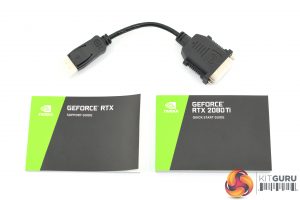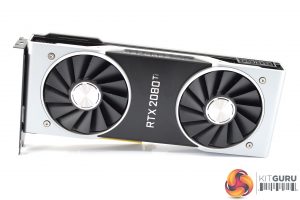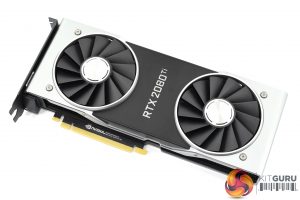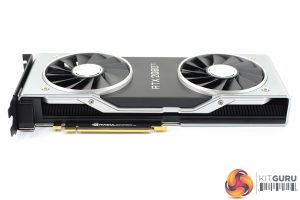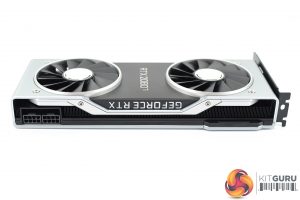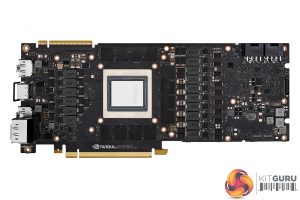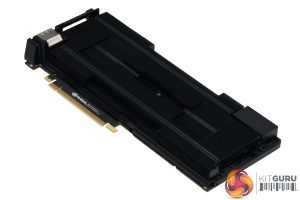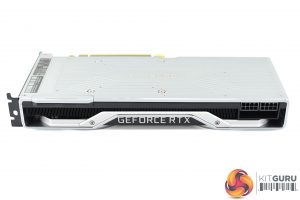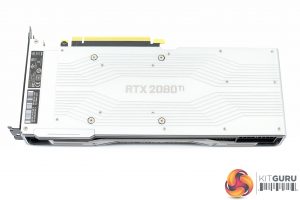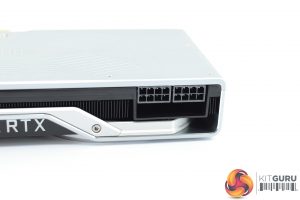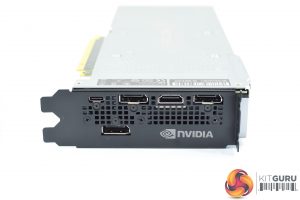The Nvidia RTX 2080 Ti Founders Edition ships in the same style of box we have seen from previous Nvidia reference cards – it's compact, with prominent RTX branding on the front of the box, while there are also the unmistakable Nvidia green accents as well.
Inside the box, we don't get much in the way of accessories. One support guide, one quick start guide, and one DisplayPort to DVI adapter is all that is included – but it is the card we are interested in.
Sporting a near identical design to the RTX 2080 (the only differences being the logos and power connectors), The RTX 2080 Ti Founders Edition really is a stunning card.
Not only is it manufactured from machine-finished aluminium which gives it an incredibly premium feel, but it has also ditched the blower-style cooling setup of previous reference cards. Instead, we find dual axial fans that look similar to the ASUS Strix fans found on their GTX 10 series cards. These fans measure 90mm in diameter, with 13 blades per fan. Each fan is also powered by a three-phase motor which Nvidia says helps to reduce unwanted noise from vibrations.
Taking the card as a whole, it measures 266.74mm long and 115.7mm high. Unlike many aftermarket card manufacturers, who are making thicker and thicker cards, this Founders Edition remains a 2-slot card.
Along either side of the card you can see the aluminium fins which work in tandem with a full-length vapour chamber to cool the GPU. Air from the two fans is exhausted out of these sides, as well as through the back of the card.
The RTX 2080 Ti sports a brand-new 13-phase iMON DrMOS power supply – and for reference, the GTX 1080 Ti uses a 7-phase dual-FET design.
A key feature of this iMON power supply design is its dynamic power management system which can handle current monitoring and control at the sub-millisecond level. This means it has very tight control of over the power flow to the GPU – thus allowing for improved power headroom which should help with overclocking.
The other key part of the iMON supply is its ability to dynamically use less power phases when not running under full load, as this enables the power supply to run at maximum efficiency when there is little load on the system – when your PC is idling, for instance.
In terms of the cooler, we have seen vapour chambers used on previous generation Nvidia reference cards – but this is the first time we have seen a full-length vapour chamber on any graphics card, let alone one manufactured by Nvidia itself. This chamber, coupled with an aluminium fin stack, promises significantly better cooling than previous reference designs.
The GeForce RTX logo takes prides of place on the side of the card, and this lights up in the classic Nvidia green once your system is powered on.
The RTX 2080 Ti logo is also positioned right in the middle of the silver aluminium backplate, and I have to say it is a lovely design. It is definitely more eye-catching than the previous all-black backplates Nvidia used, but it is still colour-neutral and should not clash with your system's colour scheme. We also expect to see this backplate help with heat dissipation.
To power the RTX 2080 Ti you need 2x 8-pin PCIe power connectors, and for those interested we look at power consumption later in the review.
Display outputs have changed slightly from the GTX 1080 Ti as well, as we now find 3x DisplayPort 1.4a, 1x HDMI 2.0b and even 1x VirtualLink (USB-C) ports. This latter port is designed for use with next-gen VR HMDs which will only require a single USB-C cable to connect to your PC.
 KitGuru KitGuru.net – Tech News | Hardware News | Hardware Reviews | IOS | Mobile | Gaming | Graphics Cards
KitGuru KitGuru.net – Tech News | Hardware News | Hardware Reviews | IOS | Mobile | Gaming | Graphics Cards



